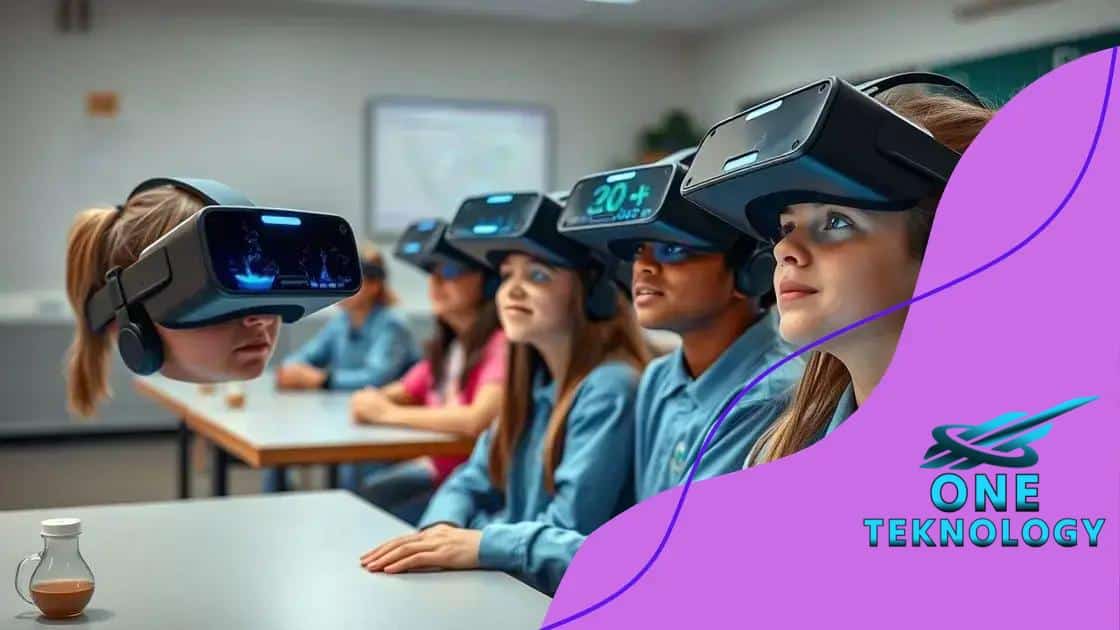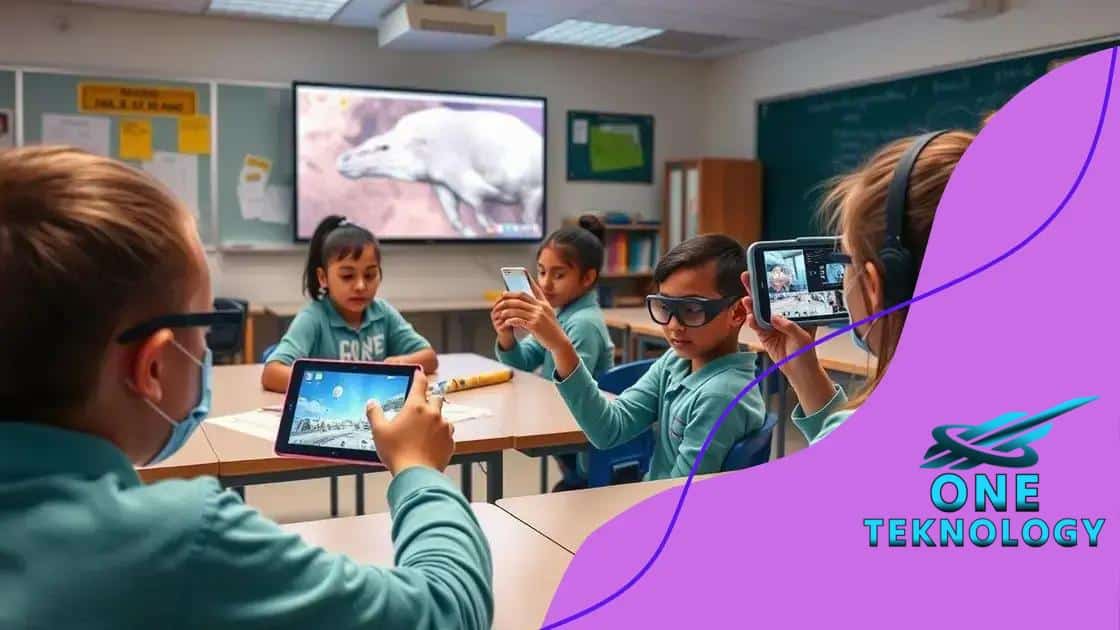How AR is being used for hands-on learning experiences

Augmented reality (AR) is being used for hands-on learning experiences by making education interactive, engaging students through immersive content that enhances understanding and retention of various subjects.
How AR is being used for hands-on learning experiences is reshaping the way students engage with educational content. Imagine walking through a historical site or performing a science experiment, all from your classroom. Curious about how this technology can enhance learning? Let’s explore!
Understanding augmented reality in education
Understanding augmented reality in education is crucial for enhancing how students interact with learning materials. By blending digital information with the real world, AR creates immersive learning environments. This technology allows students to visualize complex concepts and engage more actively in their education.
What is augmented reality?
Augmented reality is a technology that overlays digital content onto the real world through devices like smartphones and tablets. This means students can see 3D models, animations, and information interactively in their physical surroundings.
Benefits of using AR in education
- Enhanced engagement: AR captivates students’ attention, making lessons more interactive.
- Improved retention: By visualizing information, learners remember concepts more effectively.
- Real-world applications: Students can see how classroom lessons apply to the real world.
Incorporating augmented reality helps bridge the gap between theory and practice. For instance, history lessons can come alive when students see historical events as immersive experiences. This not only improves understanding but also increases interest in the subject matter.
AR in various subjects
Different subjects benefit from AR in unique ways. In science, students can visualize complex biological processes. In mathematics, they can manipulate 3D shapes to understand geometry better. Such applications make learning dynamic and relevant.
Despite its benefits, implementing augmented reality in education also presents challenges, such as the need for proper training for educators and access to technology. However, the potential to transform learning environments is significant, making it essential for educational institutions to explore AR further.
Benefits of AR for hands-on learning
The benefits of AR for hands-on learning are numerous and impactful. By enhancing the learning experience, augmented reality engages students in a way traditional methods often can’t. Through interactive elements, AR bridges the gap between theory and real-world application.
Enhanced Engagement
One of the key benefits of AR is enhanced engagement. When students use AR tools, they become active participants in their learning process. This immersion makes lessons exciting and memorable. Students can explore complex subjects like anatomy by viewing 3D models that animate in real time.
Improved Retention
AR not only captures attention but also improves knowledge retention. Visual and interactive learning methods lead to better recall compared to standard lectures. When learners see concepts applied in real scenarios, it deepens their understanding.
- Interactive experiences: Engaging with content through AR allows students to physically interact while they learn.
- Real-life simulations: AR can simulate dangerous or challenging environments safely, such as chemical reactions or architectural designs.
- Adaptive learning: Students can learn at their own pace, revisiting challenging topics through AR modules as needed.
This technology proves especially beneficial in vocational training, where practical skills are essential. For instance, medical students can practice surgeries using AR without any risk, which prepares them for real situations.
Accessibility and Collaboration
Another considerable advantage of AR is its potential for accessibility. It can break down barriers for students with different learning styles. Visual learners particularly benefit from seeing concepts rather than just hearing about them. Furthermore, AR promotes collaboration among students, allowing them to work together on projects in an immersive environment.
With the many benefits of AR for hands-on learning, educational institutions are increasingly exploring its role in classrooms. Schools using AR are often seeing higher student motivation and achievement rates, making it an exciting field for future development.
Real-world applications of AR in classrooms

Real-world applications of AR in classrooms offer exciting opportunities for enhancing education. By integrating augmented reality, teachers can create engaging, interactive experiences for students. This technology brings lessons to life and helps students understand complex subjects more easily.
Science and Biology
In science classes, AR provides students with the ability to visualize intricate processes. For example, they can explore the human anatomy in 3D. Using AR applications, students observe how organs function and how systems interact. Such visualization helps solidify knowledge that might be abstract in traditional textbooks.
History Lessons
AR also transforms history lessons. Students can witness historical events firsthand through immersive experiences. They can explore ancient civilizations or important historical sites as if they were physically present. This kind of engagement increases curiosity and helps students retain historical facts more effectively.
- Field trips: With AR, virtual field trips to places that are difficult to access become possible.
- Interactive timelines: Students can interact with major events through dynamic timelines that come to life.
- Personalized learning: Students can learn at their own pace, diving deeper into topics of interest.
Language learning also benefits from AR as students can practice pronunciation and vocabulary through interactive applications. By seeing words and images together, learners make connections that enhance their language acquisition. This immersive experience makes learning more relevant and engaging.
Mathematics Practice
Mathematics becomes more understandable with AR tools that visualize problems. Students can manipulate 3D shapes to grasp geometry concepts better. This hands-on approach fosters critical thinking and problem-solving skills, essential in math education.
The implementation of real-world applications of AR in classrooms not only makes learning enjoyable but also prepares students for a tech-savvy future. Teachers increasingly recognize how effective this technology is for increasing student engagement and knowledge retention.
Challenges of implementing AR technology
Implementing AR technology in education comes with several challenges that educators and institutions must face. While the benefits are evident, understanding these obstacles is crucial for successful integration into classrooms.
Technical Limitations
One significant challenge is the technical limitations of AR tools. Not all schools have access to the necessary hardware or high-speed internet. Without proper devices, students cannot fully experience the interactive nature of AR. Moreover, ensuring that AR applications function well on various devices can be problematic, leading to inconsistent learning experiences.
Training for Educators
Another critical factor is the need for training educators to use AR effectively. Teachers must understand not only how to operate AR tools but also how to integrate them into their lessons meaningfully. Many educators may feel overwhelmed or unprepared to adopt new technologies without proper support and training.
- Professional development: Ongoing training programs are essential for teachers to build confidence in using AR.
- Support systems: Schools need to establish support systems to help teachers troubleshoot AR-related issues.
- Curriculum alignment: Educators must align AR tools with learning objectives to ensure effectiveness.
Another challenge is the cost involved in implementing AR technology. Purchasing devices and software can be expensive, especially for schools with limited budgets. This financial barrier can prevent equal access for all students, creating disparities in educational opportunities.
Content Development
Creating appropriate content for AR platforms is also complex. Educational content must be engaging and accurate, which requires collaboration among educators, developers, and subject matter experts. Without a clear strategy for content creation, schools might struggle to provide meaningful AR experiences.
Finally, some students may experience motion sickness or distraction when using AR. Addressing these health concerns is important as well. Schools should monitor students’ reactions to AR content and adjust how it is implemented to ensure a positive experience.
Future trends in AR for education
The future trends in AR for education promise exciting developments that could reshape learning environments. As technology evolves, augmented reality will likely become more accessible and effective in engaging students.
Increased Accessibility
One major trend is the increased accessibility of AR tools. As devices become more affordable, more schools will have the resources to implement AR in their classrooms. This will help bridge the gap between students from different backgrounds, ensuring that everyone has the opportunity to benefit from these innovative learning experiences.
Enhanced Content Creation
Another trend is the improvement in content creation for AR experiences. Developers are focusing on creating more educational content that aligns with various curricula. Schools will see a wider range of AR applications tailored to meet specific educational objectives, making lessons more engaging and effective.
- Collaborative learning: Future AR applications will emphasize teamwork, allowing students to work together on projects from different locations.
- Real-world integration: AR will continue to blend lessons with real-world scenarios, helping students see and apply knowledge in practical contexts.
- Gamification: By incorporating game-like elements into learning, AR can motivate students and enhance their enthusiasm for subjects.
Furthermore, advances in artificial intelligence may lead to personalized AR experiences. These tools could adapt to each student’s learning style, providing tailored instructional support. For instance, an AR app could identify areas where a student struggles and offer additional resources specific to their needs.
Interdisciplinary Learning
Future trends will also likely include a greater focus on interdisciplinary learning. AR can connect various subjects, allowing students to explore complex topics that span different fields. For example, a project on climate change could integrate science, geography, and social studies, enabling a more holistic understanding of the issue.
As these trends continue to develop, the integration of AR in education will play a critical role in preparing students for the future. By embracing this technology, educators can create more dynamic, interactive, and relevant learning experiences that promote growth and curiosity.
In conclusion, augmented reality has the potential to significantly transform education by making learning more engaging and interactive. As AR technology continues to develop, it will become increasingly accessible for schools. By embracing these innovations, educators can create enriching experiences that capture students’ imaginations and prepare them for future challenges. While there are challenges to overcome, the exciting possibilities of AR in classrooms far outweigh the difficulties. Together, we can pave the way for a brighter, more interactive educational landscape.
FAQ – Frequently Asked Questions about AR in Education
What are the main benefits of using AR in education?
AR enhances engagement and retention by making learning experiences interactive and visual.
How does AR improve accessibility in classrooms?
AR technology becomes more affordable, allowing more schools to implement it, leading to equal access for students.
What content can be created for AR in education?
Education-focused AR content can cover various subjects, making lessons more engaging and relevant to students.
What challenges come with implementing AR technology?
Challenges include technical limitations, the need for teacher training, and ensuring access to necessary devices.






